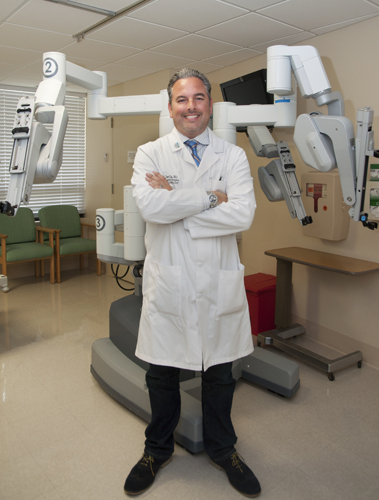Every year, about 13,000 people die of renal (kidney) cancer in the U.S. It is the most lethal of all the common urologic cancers, but recent advances in diagnosis and treatment have increased odds for survival.
Traditionally, 30 percent to 40 percent of patients have died of their cancer, in contrast to the 20 percent mortality rates associated with prostate and bladder cancer. Major causes are smoking, obesity, hypertension and family history, and, of the approximately 54,000 new cases diagnosed in the U.S. each year, the male-to-female ratio is 3:2.
Dr. Hugo Davila and partners Marc Rose and Steven Hulecki opened Indian River Urology Associates in Sebastian about seven months ago and have an office in Vero Beach as well, to offer area patients the latest advances in medical technology.
A couple of decades ago, “renal masses” were looked for only when a patient displayed certain symptoms: blood in the urine, abdominal pain, nausea, vomiting, which usually occurred only after the mass had reached 7 to 10 centimeters, Davila explained.
Many masses remained asymptomatic, undetectable even by touch, allowing the disease to become far more advanced, dangerous and difficult to successfully treat. With the advent of versatile diagnostic tools like ultrasound and CT scanning, renal masses were being discovered much earlier, Davila explained.
Doctors employing ultrasound or CT for a totally unrelated problem would often incidentally find a mass on the kidney, thus enabling the patient to receive treatment much earlier, and therefore usually more effectively. More than half of renal cancer cases are found this way.
Technological advances have also expanded treatment techniques. Instead of removing the entire kidney, doctors can now, in many cases, remove only the mass, a process known as a partial nephrectomy – removing the tumor but saving the kidney. A partial nephrectomy can often be performed through minimally invasive surgery, a technique being used more and more frequently across several medical specialties.
Minimally invasive surgery can be either laparoscopic or percutaneous: in the former, the surgeon may choose robotic-assisted surgery, to remove only the tumor or the entire kidney, as indicated. Here, the movements of the surgeon’s hands, while not touching the patient, are precisely duplicated by the equipment inside the body. This allows the surgeon more freedom, says Davila. Or the surgeon may manipulate the instruments himself by hand, through very tiny incisions.
Percutaneous surgery, Davila continued, involves the surgeon making a small incision in the patient’s back to access the kidney, then using a hollow tube and probe, locating and removing the tumor.
Which procedure is best depends on the location and size of the tumor. Some are simply too large or in a position, often in the middle of the kidney, that does not permit a minimally invasive procedure, in which case, partial or radical, open surgery may be necessary. “Like real estate,” Davila comments, “it’s all about location, location, location.”
When a minimally invasive procedure is employed and the kidney has to be removed or the tumor is too big, the surgeon will make a “bikini incision” and extract the kidney or mass through a tube. “I ask the male patients where they wear their pants,” Davila says. He then makes the bikini incision “below the belt” so it will not be visible.
Compared to an open nephrectomy, the new techniques allow far smaller incisions, shorter hospital stays, faster and much less painful recovery time, less blood loss and less chance of infection. “There are only 3 to 4 little holes, the patient is in the hospital 1 to 2 days and, in two weeks, is back to normal life.”
When the growth is removed and the kidney saved, Davila continues, the patient’s life expectancy is about the same as if the entire kidney had been removed.
The advice for patients with kidney issues, with a single kidney or simply to maintain kidney health is basic and important: avoid obesity; avoid high blood pressure; eat healthy foods and exercise to avoid Type II diabetes, which can cause kidney issues.
Davila trained at the University of South Florida in Tampa and at Tampa’s Moffett Cancer Center, where he used robotic surgery in several situations, including partial nephrectomies. He was in private practice in Michigan when his wife and family prevailed upon him to find someplace “warmer than Michigan.” He was acquainted with Rose and Hulecki, and decided to look at the Sebastian area.
“The Sebastian hospital was a key component in my decision to move here,” he said, because it is “committed to continue developing minimally invasive equipment. About three years ago, they bought the DaVinci equipment, which can be used for many different procedures. It is a huge commitment. You need not only the equipment but also trained surgeons and support staff. Here we have nurses and physician’s assistants trained in robotic surgery.”
Davila is happy to have his family in the Sebastian area. “I really like the community. It is family-oriented, with good schools, and we enjoy being near the water.”
It is Davila’s belief that “small hospitals, such as SRMC, with about 154 beds are the future of the health system. Given Sebastian River Medical Center’s commitment of time, effort and money to offer the best care, “the community is very lucky!”

